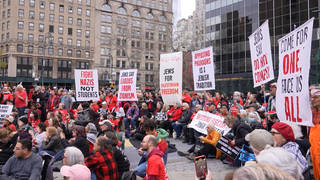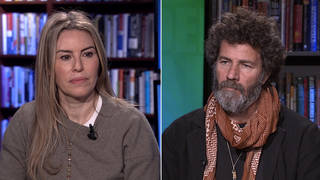
Guests
- Antonia Juhaszlongtime oil and energy journalist. Her books include Black Tide: the Devastating Impact of the Gulf Oil Spill and The Tyranny of Oil: The World’s Most Powerful Industry—and What We Must Do to Stop It.
Today in San Francisco, the Rise Against Climate Capitalism conference—a counter-conference to California Governor Jerry Brown’s Global Climate Action Summit—will focus on the common goals of climate activists and labor. That’s also the subject of an explosive new report: “Death on the Dakota Access: An Investigation into the Deadly Business of Building Oil and Gas Pipelines.” We speak with Antonia Juhasz, a longtime oil and energy journalist, about her new investigation for Pacific Standard magazine on the deaths of two men who worked on the Dakota Access pipeline, and the massive oil and natural gas boom that has generated some of the deadliest jobs in the country.
Transcript
AMY GOODMAN: We are broadcasting from San Francisco, the site of this week’s Global Climate Action Summit. I’m Amy Goodman. Thousands, tens of thousands of people marched here in San Francisco Saturday to demand action on climate, jobs and justice, as they kicked off the Rise Against Climate Capitalism conference, a counter-conference to California Governor Jerry Brown’s Global Climate Action Summit.
Today the conference will highlight the common goals of climate activists and labor. That’s also the focus of an explosive new report headlined “Death on the Dakota Access: An investigation into the deadly business of building oil and gas pipelines,” published today in the Pacific Standard magazine. It looks at the deaths of two men who worked on DAPL—that’s the Dakota Access pipeline—and the massive oil and natural gas boom that’s generated some of the deadliest jobs in the country.
For more, we’re joined by the report’s author, Antonia Juhasz, longtime oil and energy journalist. Her books include Black Tide: The Devastating Impact of the Gulf Oil Spill and The Tyranny of Oil: The World’s Most Powerful Industry—and What We Must Do to Stop It.
Welcome back to Democracy Now! It’s great to have you with us, Antonia.
ANTONIA JUHASZ: Thanks for having me, Amy.
AMY GOODMAN: So talk about why you began this piece, why you started this investigation, “Death on the Dakota Access.”
ANTONIA JUHASZ: Yeah, I’d been covering Standing Rock for some time, and I was actually doing an interview with LaDonna Brave Bull Allard in Standing Rock, and she told me that back in 2014 when she first learned of Dakota Access pipeline, she knew she was going to oppose it. And the reason why, she told me, was, “No one is going to build an oil pipeline over my son’s grave,” because of how close it would pass to where her son was buried.
That death got me to thinking about the pipeline itself as a source of injury and harm and death, not just spills that might come from it, and have, or leaks, or where it was being built, but then the people involved in building it. And I started looking at construction and learned of the death of a young man who was building the Dakota Access pipeline, Nicholas Janesich, 27 years old, and his death was reported by the AP.
I started to dig into what had happened to him, and as I started doing that investigating, I learned that just three days later, at the opposite end of the pipeline, another worker building the Dakota Access pipeline had died during construction. So then I said, “I need to learn more about oil and gas pipeline construction,” and went to the Bureau of Labor Statistics to look at fatality rate data, because I had already learned that the drilling of oil and natural gas, so the extraction workers, has been found to be one of the deadliest jobs in America, with fatality rates as high as seven times the national average. So I went to see what were the fatality rates for oil and gas pipeline construction workers, only to learn that they had never been run. The Bureau of Labor Statistics had never run that data. They didn’t even start counting deaths in this sector until 2003.
So I pulled the data together myself. With instruction from Bureau of Labor Statistics, I figured out how to run the fatality rate data myself, did, and learned that building oil and natural gas pipelines is also among one of the deadliest jobs in America, and that in 2016 they had a fatality rate of 3.6 times the national job average, and they, too, had reached highs of seven times the national average at their highest points. So these are deadly jobs and a deadly job sector that hasn’t been exposed or discussed as such.
AMY GOODMAN: So tell us how Nicholas Janesich died.
ANTONIA JUHASZ: So, this took some finding out, because he had died alone. One of the things that makes building oil and natural gas pipelines increasingly more dangerous is, one, the pace at which they’re being built to keep up with the boom in oil and natural gas production, which is a result of the boom in fracking. And North Dakota is the heart of this. So, they’re being built at an extremely fast pace and clip, but also at much further distances from towns or city centers—very, very rural areas and exceptionally more so. So he’s out towards the top of the Dakota Access pipeline, near Tioga, North Dakota, and he’s alone.
So I had to piece together from interviews with police, through a Freedom of Information Act request, a bunch of—a lot of investigation, what happened. And what happened was, we think, he was working at the very tail end, which should be one of the safest parts of pipeline construction. And he had never done it before. He was only three weeks into the job. But he was at the part where the pipeline’s in the ground, the dirt’s been laid over it, and he is resoiling the area. He’s driving a tractor. And something goes wrong with the tractor. He gets out to fix it on his own, rather than waiting to have a repair person fix it, because that probably—the logic being that would cost money, and you don’t want to cost the company money. He fixes it himself. There’s no manual in the tractor. And we also learned that the tractor had been jerry-rigged by the company that owned it to make it work differently than it was designed to work.
He gets out, and this tractor actually has a piece of equipment on it called the ripper, which was scythelike blades that rip through the dirt. He sticks something into the ripper. The spring recoils back and hits him in the skull, fracturing his skull. He gets back into the tractor, slumps over the tractor and happens to be discovered by his foreman, who’s driving another worker to another job site and notices his tractor sitting idle. And he dies less than 24 hours later at a small hospital in Minot, North Dakota.
AMY GOODMAN: And who was he working for?
ANTONIA JUHASZ: So this is the part that then becomes sort of the mystery of how you even connect worker injury and death to pipelines, because the pipeline companies have taken advantage of loopholes in corporate—the way that a company can be composed, that have allowed for a great distancing between the person doing the work and the company that runs the pipeline, making it often very difficult to even identify a death or injury with the pipeline that they’re working on.
So, Nicholas—he’s known as Nick J. to his friends—is working, a temporary employee, hired through his union, for Indianhead Pipeline Services, which is a subcontractor to Precision Pipeline, which is a subcontractor to Dakota Access, LLC. Dakota Access, LLC is the developer of a company that is owned by Energy Transfer Partners, which is itself a subset of Energy Transfer Equity, which itself is a subset of a company called LE GP, LLC.
And that’s just one set of companies associated with this pipeline, because the Dakota Access pipeline is part of the larger Bakken Pipeline system, which carries the oil first from North Dakota to Illinois, then from Illinois to Texas. The Bakken Pipeline system—I could spend the next 20 minutes going through the companies that own the Bakken Pipeline system, none of which were then associated with the deaths of Nicholas Janesich and then the second death that I uncovered, which had not been previously reported as associated with DAPL, because it wasn’t known that it was associated with DAPL—Troy Dolen was hired by Precision. And those are the only companies named in the deaths of those workers.
AMY GOODMAN: And what happened, very quickly, to Troy Dolen?
ANTONIA JUHASZ: Troy Dolen was working at the other end of the pipeline. He essentially had been suffering from heat stroke all day long. It was very clear that he had been. He was never sent home. He was never told not to work. He was put in a position of flagger, which is the moving of the equipment to and from the job site, the DAPL construction site. And he apparently went to go seek shade underneath a massive lowboy truck trailer and probably passed out, and the truck driver pulled forward not knowing he was there, and ran him over and killed him.
AMY GOODMAN: They were both buried—they don’t know each other; they’re working at opposite ends of the pipeline—on the same day?
ANTONIA JUHASZ: That’s right. September 2nd, 2016, their funerals were both held. And, you know, what I found in interviewing pipeline workers who—Evan Whiteford with LIUNA, the Laborers’ International Union of North America, which is the largest union representing Dakota Access pipeline workers—was that there is a tremendous sense of necessity of security and protection for their workers. Like most oil sector workers, many of these people are former veterans who came back. When they came back, they liked the teamwork of this type of work. They understand that there’s danger involved. But they also say this work has gotten much more dangerous. And then there is concern that it’s more dangerous still under the Trump administration because of the rollback in the already-weak protections.
AMY GOODMAN: And I can only think of September 2nd, 2016—that’s the day we arrived, Democracy Now arrived, in North Dakota, September 3rd being the day of the dogs, when Dakota Access pipeline guards unleashed dogs on the Native American water protectors who were protesting the destruction of their sacred ground.
ANTONIA JUHASZ: That’s right.
AMY GOODMAN: All of this converging. But you mentioned Trump, and I wanted to turn to May of last year, when now-President Trump travels to Mandan, North Dakota, where he celebrates his decision to pull out of the landmark 2015 climate deal, while speaking outside an oil refinery.
PRESIDENT DONALD TRUMP: In order to protect American industry and workers, we withdrew the United States from the job-killing Paris climate accord. Job killer. People have no idea. Many people have no idea how bad that was. And right here in North Dakota, the Dakota Access pipeline is finally open for business.
AMY GOODMAN: So, that’s President Trump in Mandan, and Antonia Juhasz notes that standing at Trump’s side was “fracking king” Harold Hamm, the so-called Baron of the Bakken, chief executive officer of Continental Resources, one of the Bakken’s largest producers.
ANTONIA JUHASZ: That’s right.
AMY GOODMAN: Antonia?
ANTONIA JUHASZ: Harold Hamm was referred to before and after the election as “Trump’s energy whisperer.” He has some of the largest holdings in the Bakken and the most invested in getting that oil out of North Dakota. Because the problem faced by producers in North Dakota was that deregulation and the onset of fracking allowed for this massive boom—a 10 times increase from 2006 to 2016, 10 times oil production in North Dakota—but they were having trouble getting it out of the state. So, the pipeline was a necessity for Hamm.
And while it, of course, began during the Obama administration, it was significantly slowed down at the end of that administration. But one of the very first things that Trump did was sign an executive order, as soon as he came into office, authorizing completion of the pipeline. As soon as it was done, it served its purpose, and production increased even more so, dramatically, again in North Dakota, after the pipeline was completed.
And for Harold Hamm, that led to a significant increase in production in the state, in the value of his stock, in literally a reduction in the cost of every single barrel of oil that he produces everywhere, and his very first shipment ever of oil to China.
AMY GOODMAN: And you have a sub-piece within your larger piece: “Trump and Friends Cash In: Members and backers of the Trump administration are profiting from DAPL while scheming to make even bigger bucks shipping oil and petrochemicals overseas.” You have Harold Hamm, you have Kelcy Warren.
ANTONIA JUHASZ: The CEO of Energy Transfer Partners, a major backer of the Trump campaign, and then, of course, the immediate probably largest beneficiary of the completion of the Dakota Access pipeline. Actually, Kelcy Warren had first backed Rick Perry for president, with a $5 million investment in Perry’s campaign. Perry was on the board of Energy Transfer Partners, then became energy secretary, a position from which he significantly advanced the completion of pipelines, including DAPL.
AMY GOODMAN: And Commerce Secretary Wilbur Ross.
ANTONIA JUHASZ: So Wilbur Ross is, I think, a critically important piece of all of these players. Ross, first he was known as the king of bankruptcy. His main area is going in, finding bankrupt companies, turning them over to make a profit. In the Bakken, many of these small companies had been suffering before DAPL was completed, and were going into bankruptcy, and a lot of companies came in to make money off of this, including Wilbur Ross’s companies.
But he looked forward, and he’s also heavily invested in shipping, the shipping of oil and natural gas and petrochemicals through Navigator and Diamond S. His companies are set up to partner with Energy Transfer Partners, which is not only building pipelines, but is building infrastructure to convert that oil and natural gas into petrochemicals to make plastics, and then ship that product overseas, including though Wilbur Ross’s companies, with contracts that are already signed for China.
So what the companies are seeing, including ExxonMobil—so Rex Tillerson, former secretary of state, former head of ExxonMobil, is one of the Trumpers who cash in—is all this work that we’re seeing through the Global Climate Action Summit and Rise for Climate Justice, one of the end goals is to see a reduction in fossil fuels for use of energy and use of transportation. Well, the companies are seeing this, too, and they’re looking forward to petrochemicals. And ExxonMobil alone is predicting—is invested in a $20 billion investment in petrochemical infrastructure. Wilbur Ross’s companies are predicting—former companies now—a $100 billion increase.
AMY GOODMAN: We have 20 seconds. And you’d like to see water pipelines built?
ANTONIA JUHASZ: That’s right. So the solution is—the building of oil and natural gas pipelines, incredibly dangerous work—what we really need in the United States is a massive investment in water pipeline construction. Same job skills, same unions. Those same workers can build water pipelines.
AMY GOODMAN: Well, we’re going to do Part 2 of this and post it online at democracynow.org. Antonia Juhasz, oil and energy journalist. We’ll link to her latest piece in the Pacific Standard, headlined “Death on the Dakota Access.” I’m Amy Goodman. Thanks so much for joining us.











Media Options